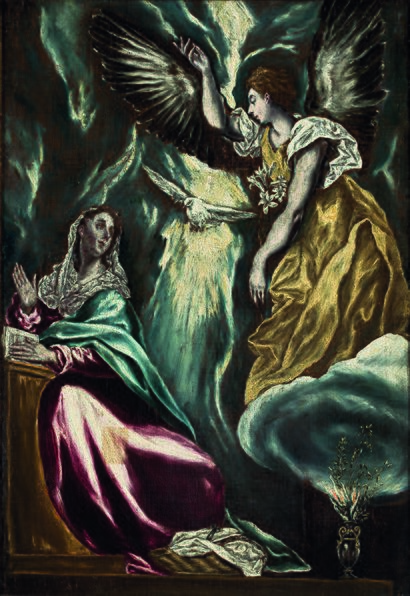Annunciation (El Greco, São Paulo Museum of Art) facts for kids
Quick facts for kids Annunciation |
|
|---|---|
 |
|
| Artist | El Greco |
| Year | 1600 |
| Medium | oil on canvas |
| Dimensions | 107 cm × 74 cm (42 in × 29 in) |
| Location | São Paulo Museum of Art |
The Annunciation is a famous painting created in 1600 by the artist El Greco. It is currently displayed at the São Paulo Museum of Art in Brazil. This painting shows a very important moment from the Bible, known as the Annunciation.
Contents
What is the Annunciation?
The Annunciation is a key event in Christian beliefs. It describes the moment when the Archangel Gabriel visited Mary. Gabriel told Mary that she would become the mother of Jesus Christ, the Son of God. This event is celebrated every year on March 25th.
Why is this event important?
- It marks the beginning of Jesus's life on Earth.
- It shows God's plan to save humanity.
- It is a moment of great faith and wonder.
Who was El Greco?
El Greco was a Greek painter, sculptor, and architect of the Spanish Renaissance. His real name was Doménikos Theotokópoulos. He was born in Crete, which was part of the Republic of Venice at the time. Later, he moved to Spain and spent most of his life there.
El Greco's Unique Style
El Greco is known for his very special and unique painting style.
- Long, thin figures: His paintings often show people with stretched-out bodies and limbs.
- Bright, unusual colors: He used bold and sometimes strange color combinations.
- Dramatic lighting: His works often have strong contrasts between light and shadow, creating a powerful mood.
- Spiritual feeling: El Greco's art often feels very spiritual and emotional, showing deep religious ideas.
How did El Greco develop his style?
El Greco studied art in Venice and Rome, Italy. He learned from great masters like Titian and Tintoretto. But he didn't just copy them. He took what he learned and added his own ideas, creating a style that was truly his own. He moved to Toledo, Spain in 1577, where he lived and worked for the rest of his life. It was in Toledo that he created many of his most famous paintings, including several versions of the Annunciation.
About the Painting: Annunciation (1600)
El Greco painted several versions of the Annunciation throughout his career. The one in the São Paulo Museum of Art is from 1600, near the end of his life. This painting shows his mature style.
What can you see in the painting?
- Mary: She is usually shown kneeling or sitting, often looking surprised or humble.
- Archangel Gabriel: He is typically shown with wings, bringing the message to Mary. He might be pointing upwards or making a gesture of announcement.
- Holy Spirit: Often represented by a dove, symbolizing the Holy Spirit, usually appearing from above.
- Heavenly light: A bright light often shines down, showing the divine presence.
- Symbolic objects: You might see lilies, which symbolize purity, or a book, representing Mary's piety.
The São Paulo Annunciation's Details
In this specific painting, El Greco uses his signature style to make the scene feel very dramatic and spiritual. The figures are elongated, and the colors are vibrant. The way light is used draws your eye to the most important parts of the scene, making the moment feel truly divine. This painting is a great example of how El Greco brought emotion and spirituality into his art.
Why is this painting important?
- It shows El Greco's mastery of his unique style.
- It is a significant religious artwork.
- It is a valuable piece of art history, representing the Spanish Renaissance.
- It helps us understand the artistic and religious ideas of the time.
See also
 In Spanish: La Anunciación (El Greco, Museo de Arte de São Paulo) para niños
In Spanish: La Anunciación (El Greco, Museo de Arte de São Paulo) para niños

